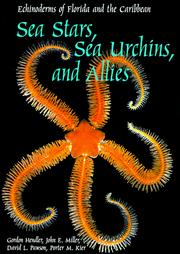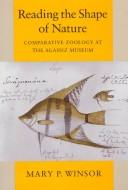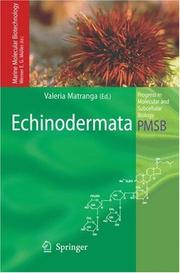| Listing 1 - 10 of 11 | << page >> |
Sort by
|

ISBN: 1560984503 Year: 1995 Publisher: Washington Smithsonian Institution Press
Abstract | Keywords | Export | Availability | Bookmark
 Loading...
Loading...Choose an application
- Reference Manager
- EndNote
- RefWorks (Direct export to RefWorks)
Echinodermata --- Identification --- Identification. --- Echinoderma --- Echinoderms --- Eleutherozoa --- Pelmatoza --- Spiny-skinned animals --- Bilateria --- Marine invertebrates
Dissertation

Year: 2017 Publisher: Liège Université de Liège (ULiège)
Abstract | Keywords | Export | Availability | Bookmark
 Loading...
Loading...Choose an application
- Reference Manager
- EndNote
- RefWorks (Direct export to RefWorks)
Les habitats benthiques d’eau profonde autour des îles maltaises font partie des régions les moins étudiées en Méditerranée. À cause d’un effort de recherche limité, les recensements attribuent à la Méditerranée centrale une biodiversité moindre qu’aux régions alentours ; le bassin ouest, les mers Egée et Adriatique. C’est également le cas pour les échinodermes ; cet embranchement d’animaux marins est en général bien étudié, mais il y a encore un manque de données concernant les espèces des grands fonds. Avec l’arrivée récente des ROVs, petits robots sous-marins téléguidés, les grands fonds deviennent de plus en plus accessibles, en particulier les systèmes rocheux tels les canyons, escarpements et récifs coralliens d’eau froide, qui ne pouvaient pas être échantillonnés correctement par chalutage. L’objectif de cet étude était d’estimer la diversité en échinodermes dans les eaux maltaises de grande profondeur à travers l’analyse de vidéos prises par ROV. En plus, les distributions spatiale et bathymétriques, densités et habitats préférés des échinodermes furent décrits. Les données vidéo furent collectionnées par le projet Life Baħar for Natura 2000 pendant les étés de 2015 et 2016, dans le cadre de leur étude des habitats benthiques maltais, délimitée par la zone de gestion des pêches de 25 miles nautiques de Malte. Au total, 25 taxons d’échinodermes ont été identifiés, et comprenaient onze étoiles de mer, deux crinoïdes, quatre ophiures, cinq oursins et trois holothuries. Parmi ces espèces, trois furent trouvées pour la première fois en eau maltaise : les étoiles de mer Marginaster capreensis, Sclerasterias neglecta, et l’holothurie Mesothuria intestinalis. Six espèces furent observées à plus grandes profondeurs que leur limite actuelle en Méditerranée. Les espèces les plus abondantes étaient les crinoïdes Antedon mediterranea et Leptometra phalangium, suivis des oursins Stylocidaris affinis et Cidaris cidaris. Les crinoïdes formaient de très denses agrégations, dans une petite zone au sud de Malte. Cette zone abrite également la seule population méditerranéenne connue à ce jour de l’étoile de mer atlantique Coronaster briareus. Les autres espèces étaient plus largement distribués dans la région étudiée. La distribution bathymétrique variait selon l’espèce concernée, et la diversité globale en échinodermes semblait être constante parmi les gammes de profondeur échantillonnées. Les habitats privilégiés dépendaient également de l’espèce, mais les systèmes rocheux dominés par des coraux d’eau profonde étaient particulièrement diversifiés. Les objets d’origine anthropiques augmentaient la diversité des fonds sédimentaires en fournissant à diverses espèces des substrats durs à coloniser. En conclusion, les grands fonds autour de l’archipel maltais s’avèrent être un système hétérogène abritant une faune diverse d’échinodermes. Par contre, il y a toujours un manque d’informations concernant la taxonomie et l’écologie de certaines espèces d’échinodermes d’eau profonde. Deep-sea benthic habitats around the Maltese islands are some of the least studied areas in the Mediterranean. Because of the limited research effort, inventories report a lower biodiversity in this area than in the surrounding regions, the Western Mediterranean, Aegean and Adriatic Sea. This is also the case for echinoderms; this marine phylum is generally well studied, but there is still a lack of data concerning deep-sea species. With the recent advent of remotely operated underwater vehicles (ROVs), the deep sea has become more accessible to scientists, especially rocky areas such as canyons, escarpments and cold-water coral reefs, which could not have been adequately sampled through trawling surveys. The aim of this study was to assess echinoderm diversity in deep Maltese waters, within the 25-nautical miles Fisheries Management Zone, through analysis of ROV video footage. In addition, the spatial and bathymetric distribution of echinoderms were described, as well as their density, preferred habitat and bottom types. Video data were acquired through ROV surveys of Maltese benthic habitats as part of the Life Baħar for Natura 2000 project in the summers of 2015 and 2016. The bathymetric range covered by the videos used in the present study was from 216m to 1030m depth. In total, 25 echinoderm taxa were identified, comprised of: 11 asteroids, 2 crinoids, 4 ophiuroids, 5 echinoids and 3 holothurians. Of these species, three were new records for Maltese waters: the sea stars Marginaster capreensis, Sclerasterias neglecta, and the holothurian Mesothuria intestinalis. Six species were observed deeper than their current accepted depth range in the Mediterranean. The most abundant species were the crinoids Antedon mediterranea and Leptometra phalangium, followed by the cidarids Stylocidaris affinis and Cidaris cidaris. Crinoids formed very dense aggregations of up to 2900 individuals/1000m², in a small area to the south of Malta. This area also hosts the only known Mediterranean population to date of the Atlantic sea star Coronaster briareus. Other echinoderms were more widely distributed across the studied area. Bathymetric distribution varied for each species, and the overall echinoderm diversity seemed stable across the surveyed depths. The preferred habitats also depended on each species, but rocky habitats dominated by deep-water corals were particularly diverse. Discarded anthropogenic objects proved to increase the diversity of sedimentary bottoms by providing colonizable hard substrata for sea stars, crinoids and sea urchins. It can be concluded that the deep sea around the Maltese islands is a heterogeneous system hosting a diverse echinoderm fauna; however, there is still a lack of knowledge concerning the taxonomy and ecology of certain deep-sea echinoderms. The findings of the present study can be used to identify ecologically important areas for conservation purposes.
echinoderms --- Malta --- Mediterranean --- deep sea --- echinoderm distribution --- echinoderm diversity --- Sciences du vivant > Zoologie
Book
ISBN: 0907151884 9780907151883 Year: 1993 Publisher: London Immel Publishing Ltd
Abstract | Keywords | Export | Availability | Bookmark
 Loading...
Loading...Choose an application
- Reference Manager
- EndNote
- RefWorks (Direct export to RefWorks)
Echinodermata --- Identification --- Identification. --- Echinoderma --- Echinoderms --- Eleutherozoa --- Pelmatoza --- Spiny-skinned animals --- Bilateria --- Marine invertebrates --- Echinodermata - Great Britain - Identification.
Book
ISBN: 1486307639 9781486307630 9781486307647 1486307647 9781486307623 1486307620 Year: 2017 Publisher: Clayton South, VIC [Canberra]
Abstract | Keywords | Export | Availability | Bookmark
 Loading...
Loading...Choose an application
- Reference Manager
- EndNote
- RefWorks (Direct export to RefWorks)
Echinodermata --- Marine invertebrates --- Aquatic invertebrates --- Marine animals --- Echinoderma --- Echinoderms --- Eleutherozoa --- Pelmatoza --- Spiny-skinned animals --- Bilateria --- Ecology. --- Evolution. --- Australian
Book
ISBN: 3110386003 3110368536 9783110368536 9783110371697 Year: 2017 Publisher: Berlin, [Germany] ; Boston, [Massachusetts] : De Gruyter,
Abstract | Keywords | Export | Availability | Bookmark
 Loading...
Loading...Choose an application
- Reference Manager
- EndNote
- RefWorks (Direct export to RefWorks)
The Handbook of Zoology aims to provide an in depth treatment of the entire animal kingdom from the lower invertebrates to the mammals. It publishes comprehensive overviews on animal systematics and morphology as well as extensive coverage of physiology, behaviour, ecology and applied aspects of zoological research. Volumes in progress include Nemathelminthes and Gnathifera, Annelida, Mollusca, Arthropoda, Arthropoda: Insecta, and Mammalia. Although our knowledge regarding many taxonomic groups has grown enormously over the last decades, it is still the ambition of the Handbook to be comprehensive in the sense that text and references together provide a solid basis for further research. Editors and authors seek a balance between describing species richness and diversity, explaining the importance of certain groups in a phylogenetic context and presenting a review of available knowledge and up-to-date reference literature. New contributions to the series present the combined effort of an international team of editors and authors, entirely published in English and explicitly addressing the international scientific community. This book is the second volume of two books about sea urchins (echinoids) since 1953 (Th. Mortensen). The detailed and coloured illustrated descriptions enable the reader to identify all species living today in our oceans. Recent scientific searchings are included. Volume II. describes the Irregularia with bilateral symmetry, including the well known "sand dollars" and "heart urchins", living mostly more or less deeply burrowed in the substrat.
Sea urchins. --- Echinodermata. --- Echinoderma --- Echinoderms --- Eleutherozoa --- Pelmatoza --- Spiny-skinned animals --- Bilateria --- Marine invertebrates --- Echinoidea --- Echinodermata --- Morphology. --- Systematics. --- Zoology.
Book
Year: 1913 Publisher: Utrecht : P. den Boer,
Abstract | Keywords | Export | Availability | Bookmark
 Loading...
Loading...Choose an application
- Reference Manager
- EndNote
- RefWorks (Direct export to RefWorks)
Sea urchins. --- Embryology. --- Echinodermata. --- Sea Urchins. --- Echinodermata. --- Oursins. --- Échinodermes. --- 42.72 porifera, coelenterates, echinoderms and brachiopods. --- Echinodermata. --- Embryology. --- Sea urchins. --- Zee-egels. --- Embryologie. --- Kiemcellen.
Book
ISBN: 0429454457 0429845758 0429845766 1138318620 Year: 2018 Publisher: Taylor & Francis
Abstract | Keywords | Export | Availability | Bookmark
 Loading...
Loading...Choose an application
- Reference Manager
- EndNote
- RefWorks (Direct export to RefWorks)
Animals living in the Southern Ocean have evolved in a singular environment. It shares many of its attributes with the high Arctic, namely low, stable temperatures, the pervading effect of ice in its many forms and extreme seasonality of light and phytobiont productivity. Antarctica is, however, the most isolated continent on Earth and is the only one that lacks a continental shelf connection with another continent. This isolation, along with the many millions of years that these conditions have existed, has produced a fauna that is both diverse, with around 17,000 marine invertebrate species living there, and has the highest proportions of endemic species of any continent. The reasons for this are discussed. The isolation, history and unusual environmental conditions have resulted in the fauna producing a range and scale of adaptations to low temperature and seasonality that are unique. The best known such adaptations include channichthyid icefish that lack haemoglobin and transport oxygen around their bodies only in solution, or the absence, in some species, of what was only 20 years ago termed the universal heat shock response.
Marine biology. --- Oceanography. --- oceanography --- marine biology --- environment --- climate change --- climate change impacts --- Southern Ocean --- high Arctic --- ice --- seasonality --- phytobiont productivity --- Antarctica --- Antarctic fauna --- marine invertebrate species --- endemic species --- low temperature adaptations --- seasonality adaptions --- channichthyid icefish --- universal heat shock response --- gametogenic cycles --- vitellogenesis --- microtubule assembly --- locomotion --- metabolic rate --- whole-animal growth --- embryonic development --- limb regeneration --- echinoderms --- Southern Ocean fauna --- ecophysiological adaptations --- coldblooded marine species

ISBN: 1283078503 9786613078506 0226902080 9780226902081 9781283078504 6613078506 0226902145 9780226902142 0226902145 9780226902142 0226902153 9780226902159 Year: 1991 Publisher: Chicago : University of Chicago Press,
Abstract | Keywords | Export | Availability | Bookmark
 Loading...
Loading...Choose an application
- Reference Manager
- EndNote
- RefWorks (Direct export to RefWorks)
Reading the Shape of Nature vividly recounts the turbulent early history of the Museum of Comparative Zoology at Harvard and the contrasting careers of its founder Louis Agassiz and his son Alexander. Through the story of this institution and the individuals who formed it, Mary P. Winsor explores the conflicting forces that shaped systematics in the second half of the nineteenth century. Debates over the philosophical foundations of classification, details of taxonomic research, the young institution's financial struggles, and the personalities of the men most deeply involved are all brought to life. In 1859, Louis Agassiz established the Museum of Comparative Zoology to house research on the ideal types that he believed were embodied in all living forms. Agassiz's vision arose from his insistence that the order inherent in the diversity of life reflected divine creation, not organic evolution. But the mortar of the new museum had scarcely dried when Darwin's Origin was published. By Louis Agassiz's death in 1873, even his former students, including his son Alexander, had defected to the evolutionist camp. Alexander, a self-made millionaire, succeeded his father as director and introduced a significantly different agenda for the museum. To trace Louis and Alexander's arguments and the style of science they established at the museum, Winsor uses many fascinating examples that even zoologists may find unfamiliar. The locus of all this activity, the museum building itself, tells its own story through a wonderful series of archival photographs.
Animals --- Natural history --- Naturalists --- History. --- Classification --- Agassiz, Louis, --- Agassiz, Alexander, --- Barbour, Thomas, --- Harvard University. --- zoology, harvard, museum, louis agassiz, science, academia, classification, taxonomy, biodiversity, creation, evolution, natural history, animals, biology, thomas barbour, echinoderms, crayfish, walter faxon, nonfiction, founding, funding, agenda, biography, father and son, scientific debate, research, scholars, insects, lamarck, specimens, display, exhibition.
Book
ISBN: 0691209499 Year: 2020 Publisher: Princeton, NJ : Princeton University Press,
Abstract | Keywords | Export | Availability | Bookmark
 Loading...
Loading...Choose an application
- Reference Manager
- EndNote
- RefWorks (Direct export to RefWorks)
This entertaining and informative book describes how living things bump up against non-biological reality. "My immodest aim," says the author, "is to change how you view your immediate surroundings." He asks us to wonder about the design of plants and animals around us: why a fish swims more rapidly than a duck can paddle, why healthy trees more commonly uproot than break, how a shark manages with such a flimsy skeleton, or how a mouse can easily survive a fall onto any surface from any height. The book will not only fascinate the general reader but will also serve as an introductory survey of biomechanics. On one hand, organisms cannot alter the earth's gravity, the properties of water, the compressibility of air, or the behavior of diffusing molecules. On the other, such physical factors form both constraints with which the evolutionary process must contend and opportunities upon which it might capitalize. Life's Devices includes examples from every major group of animals and plants, with references to recent work, with illustrative problems, and with suggestions of experiments that need only common household materials.
Biophysics. --- Antheraea. --- Argyronetes. --- Ascaris. --- Bombyx. --- Dendraster. --- Dineutes. --- Halobates. --- Halosaccion. --- Hydra. --- Luna. --- Macronema. --- Metridium. --- Mimosa. --- Nereocystis. --- Pilobolus. --- Potamodytes. --- Quetelet. --- Velcro. --- abductin. --- airfoils. --- albumin. --- axonal transport. --- bending. --- capillary. --- centroid. --- continuity. --- creeks. --- cyclosis. --- detergent. --- echinoderms. --- fabrics. --- fiberglass. --- foraminifera. --- frameworks. --- gait. --- jellyfish. --- kneecap. --- oak tree.

ISBN: 1280306335 9786610306336 3540276831 3540244026 3642063705 Year: 2005 Publisher: Berlin ; New York : Springer,
Abstract | Keywords | Export | Availability | Bookmark
 Loading...
Loading...Choose an application
- Reference Manager
- EndNote
- RefWorks (Direct export to RefWorks)
Members of the phylum Echinodermata are among the most familiar marine invertebrates. Forms such as the sea star have become virtually a symbol of sea life. Used in ancient oriental medicine as a source of bioactive compounds, sea cucumbers, sea stars and sea urchins are now used for the extraction and purification of cytotoxic, haemolytic, antiviral, antifungal, antifouling, antimicrobial and even anti-tumoural activities. In addition, of the five extant classes, sea urchins and sea cucumbers are important economic resources for current fishery and aquaculture. Molecular and cell biological techniques described in this book are, on the one hand, indicative of the improvements made over the years and, on the other, stress the need of their further exploitation for the sustainable production of bioactive compounds and their application in biomedicine.
Echinodermata. --- Invertebrates. --- Invertebrata --- Animals --- Echinoderma --- Echinoderms --- Eleutherozoa --- Pelmatoza --- Spiny-skinned animals --- Bilateria --- Marine invertebrates --- Biochemistry. --- Biotechnology. --- Cytology. --- Toxicology. --- Animal Biochemistry. --- Cell Biology. --- Pharmacology/Toxicology. --- Environmental Engineering/Biotechnology. --- Chemicals --- Medicine --- Pharmacology --- Poisoning --- Poisons --- Cell biology --- Cellular biology --- Biology --- Cells --- Cytologists --- Chemical engineering --- Genetic engineering --- Biological chemistry --- Chemical composition of organisms --- Organisms --- Physiological chemistry --- Chemistry --- Medical sciences --- Toxicology --- Composition --- Cell biology. --- Pharmacology. --- Environmental engineering. --- Environmental control --- Environmental effects --- Environmental stresses --- Engineering --- Environmental health --- Environmental protection --- Pollution --- Sustainable engineering --- Drug effects --- Medical pharmacology --- Chemotherapy --- Drugs --- Pharmacy --- Physiological effect --- Bioremediation. --- Chemical Biology. --- Experimental Organisms. --- Technique. --- Environmental biotechnology --- Biodegradation
| Listing 1 - 10 of 11 | << page >> |
Sort by
|

 Search
Search Feedback
Feedback About
About Help
Help News
News